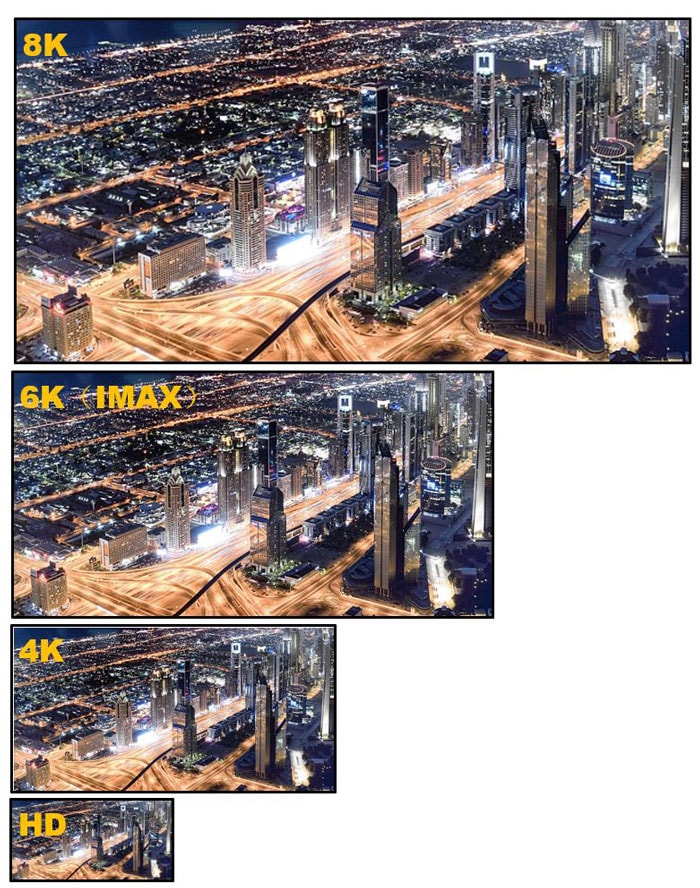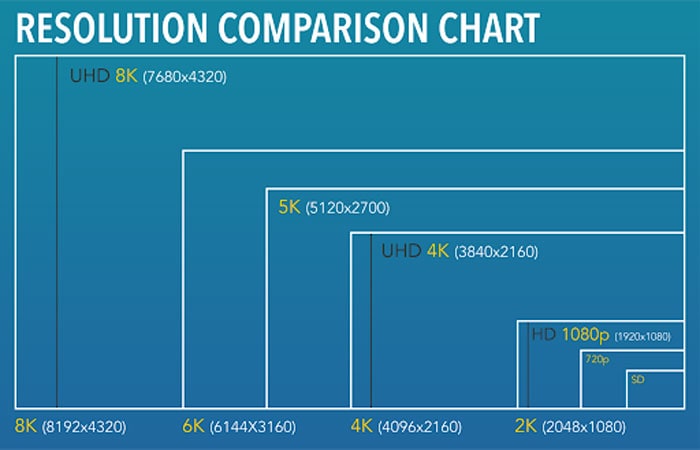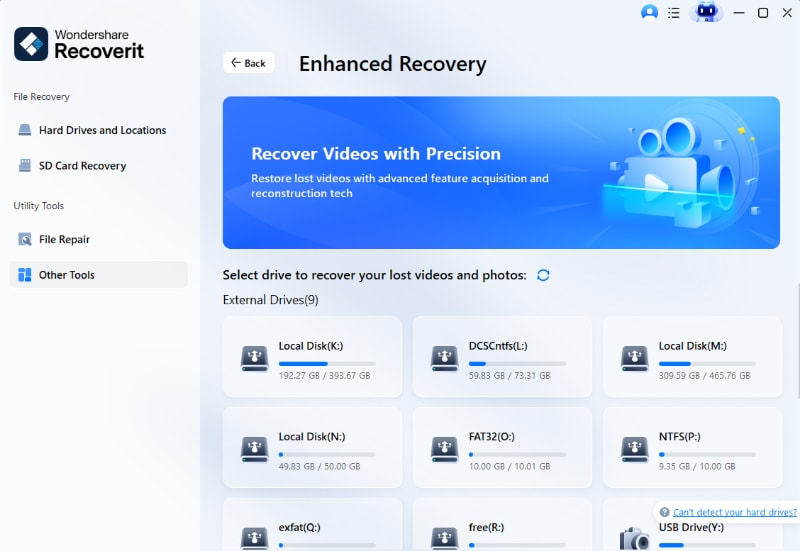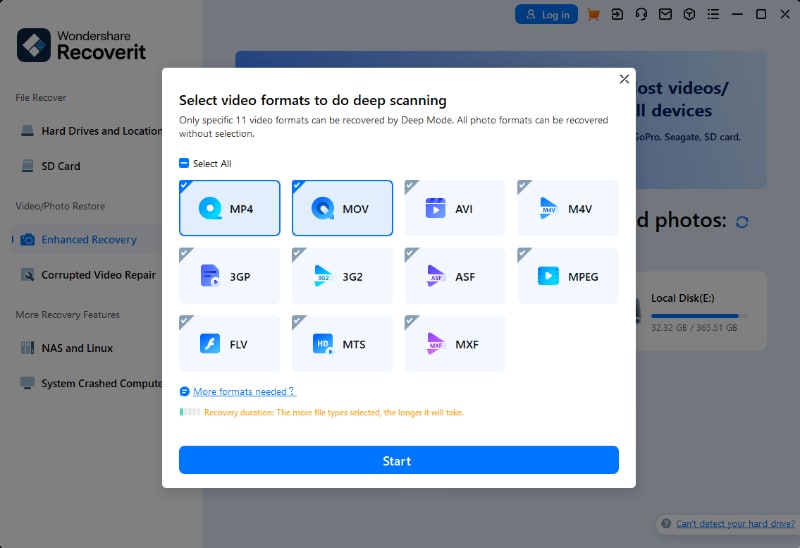We often hear about the viewing experience, but do you know what goes behind the technical aspects of it? You must have seen that 4K is the best resolution for watching movies, but do you understand what it stands for? If you are not sure, let us introduce you to the basics and then help you with selection.
Earlier, we relied on High-definition video quality to be good and then came 4K. Now we have something better with 8K; it is the successor of the 4K resolution. The technology is changing at such a fast pace that it is quite easy to lose such information. But, if you are already here, we would like to provide you with all the information needed to learn about it.
The questions to ask are - How many devices are supporting the said technology? Do you need to get the latest 8K TV for video streaming? How does 8K differ from 4K resolution? To answer all of these questions and some more, let us take you through these details post on the 4K vs 8K video.
In this article
Part 1: What are 4K and 8K Resolutions?
Before we start with the burning question of what 4K and 8K resolutions are, it is paramount to understand what is video resolution. So, video resolution can be described as the number of pixels in every single frame, which impacts the sharpness and clarity. It can be calculated using the number of pixels in a standard ratio, which is common to various display devices. However, the resolution increases with the number of pixels in each frame. The higher the pixel count, the better it looks on your screen and the video player.
Traditionally, video resolution is broken down into two main groups: standard definition (SD) and high definition (HD), with resolutions less than 720p classified as standard definition. However, with developments in display technology, additional categories have emerged, including FHD, 4K, and 8K.

4K Resolution
4K resolution, commonly known as Ultra High Definition (UHD), is a display resolution of 384.2160 pixels with an aspect ratio of around 16:9. That means it has four times the number of pixels on the horizontal and vertical lines compared to FHD (192.1080). It is also the most common resolution for high-definition (HD) video.
Furthermore, 4K resolution is becoming increasingly popular in televisions and monitors, and it is frequently used for high-definition video material like movies and television shows. The increased resolution of 4K helps for more detailed and sharper images, which is most visible while watching larger displays or sitting closer to the screen.
8K Resolution
As the successor to 4K, 8K resolution, also known as Super High Definition (SHD) or Ultra High Definition 2 (UHD-2), has a display resolution of 768.4320. It has four times more pixels than 4K and sixteen times more than FHD, with an aspect ratio of around 16:9. However, 8K UHD is one of the highest resolutions available in televisions and other digital devices.
Furthermore, for individuals who want to create enormous, highly detailed prints, 8K can be useful. Also, it allows for incredible detail in movies, games, and shows on television. However, these resolutions require more processing power and bandwidth than previous types because there is so much information being processed at once.
| Video Resolution | Alternative Name | Aspect Ration | Pixel Size |
| SD (Standard Definition) | 480p | 4:3 | 640x480 |
| FHD (Full HD) | 1080p | 16:9 | 1920x1080 |
| 4K or UHD (Ultra HD) | 2160p | 1:1.9 | 3840x2160 |
| 8K or FUHD (Full Ultra HD) | 4320p | 16:9 | 7680x4320 |
Part 2: What is the Difference of 4K vs 8K Video Resolutions?
There are a few clear differences between 4K vs 8K video resolutions with widely diverse definitions, resolutions, frame rates, quality, and audio channels. Although the difference might not be substantial to identify for the naked eye while viewing on a display screen, the technical specification is quite different.

Video resolution is a measure of quality that refers to the number of pixels or samples used per inch in either height, width, or both dimensions. The higher the pixel count, the better it will look on your screen and video player.
In simple terms, you need more pixels for greater detail because images are made up of tiny dots called "pixels." A lower-resolution image has fewer pixels across an axis, so there's less information available about what those small dots represent - it could be anything from dirt to a car door handle.

Currently, most of us are familiar with 4K, 6K, and 8K resolutions. Let's define them one by one:
- 4K Resolution: K resolution is a display resolution of 3840 x 2160. That means it has four times as many pixels on the horizontal and vertical lines than an HDTV (1920 x 1080). This makes for great detail in movies, games, or television shows.
- 6K Resolution: 6K resolution is a standard in the motion-picture industry and is used by some television broadcasters. 6K resolution has 6144 horizontal pixels, or roughly four times that of HDTV (1920 x 1080).
- 8K Resolution: An 8K resolution is a display resolution of 7680 x 4320. It also has four times more pixels than HDTVs. For those who want to make large prints that are highly detailed, this can be really helpful. This makes for great detail in movies, games, or television shows. But these resolutions come with tradeoffs - they require higher processing power and bandwidth than other forms because there's so much information being processed at once: twice as much height and width as HD TV displays but twice as much detail.

What are the Resolution Differences?
Let's start with the basics.
Resolution is a measure of how many pixels there are on your screen in one given space. The more pixels you have, the higher resolution you're going to be able to see. But it will also mean that it takes up more hard drive space and won't look as good if we try viewing this high-resolution content on a smaller device like an iPhone or iPad.
This means that for most people reading this article, anything over 720p resolution should do just fine because chances are their computer monitor or TV has at least 1080p resolution anyways.
And now let's dive into some numbers: what exactly is 2K, 4K, 8K, or 1080p or Full HD?

Before 4K became common, 2K resolution was rare. It was only used in cinema presentations, and most cinemas use 2k resolution (although some are less). The resolution is 2048 x 1080 pixels. But now, as 4K TVs become more and more popular, "2K" is quickly becoming a common shorthand for 1080p high definition.
8K resolution displays images in higher detail than 4K. 1080p screens display at a resolution of 1,920 by 1,080 pixels while 4K displays quadruple those numbers to 3,840 by 2,160. This gives an 8K resolution of 7,680 by 4,320. That's four times the number of pixels as 4K, and it's 16 times that of a 1080p TV.

In order to fully understand the concept, take a couple of steps back from your TV. Try to find a single-pixel (not one of the three subpixels (red, green, and blue lights that make up the screen). If you are looking at a 4K screen, four pixels will take up one-pixel space. If you are looking at a 1080p screen, 16 pixels will fill up 1 pixel. That's 8K. This means 8K is much sharper than 4K and much brighter than 1080p.
Here are the main differences between 4K and 8K:
- Definition: As mentioned before, 4K and 8K refer to the resolution of a video file. A 4K resolution is approximately 4000 pixels across, while an 8K resolution is approximately 8000 pixels wide. While both resolutions qualify as High Definition (HD), 4K is classified as Ultra High Definition (UHD) and 8K as Super High Definition (SHD) or Ultra High Definition 2 (UHD-2).
- Resolution: A horizontal resolution of 7680 pixels and a vertical resolution of 4320 pixels represent 8K UHD resolution. In contrast, a horizontal resolution of 3840 and a vertical resolution of 2160 reflect 4K UHD. Thus, the 8K UHD has double the horizontal and vertical resolution of the 4K UHD. Overall, 8K UHD contains 33.2 megapixels, but 4K UHD has only 8.3 megapixels.
- Frame Rate: Frame rate is the number of frames or images displayed per second on a screen. It is directly related to video quality and is commonly used to synchronize audio and images. It is believed that the greater the frame rate, the more natural the output (video quality). The 8K provides frame rates of up to 120 Hz progressive, but the 4K only allows 50 to 60 frames per second (FPS).
- Quality: With regards to image quality, 8K is often more detailed and clearer than 4K. However, the difference might not be obvious to everyone, particularly on smaller screens or from a distance. Overall, 8K resolution is regarded as the highest possible quality currently available for household televisions and monitors.
- Audio Channel: The support for audio channels changes significantly between 8K and 4K. The 8K Ultra HD provides 22.2 audio channels, whereas the 4K Ultra HD supports 5.1 channels. In addition, the 8K user can experience three-dimensional super stereo.
Related Video >>: What Is 4K, 6K, and 8K Resolution?
Part 3: Which Resolution to Choose: 8K vs 4K Resolution?
Now that you know the 4K and 8K difference, which one to pick? So, is 8K better than 4K? However, the choice between 8K vs 4K resolution entirely depends on the kind of device you are interested in. Thankfully, most digital devices are offered in multiple resolution options to choose from. You can pick the right resolution for your needs, considering the difference between 4K and 8K.
#1 TVs & Monitors

Although 8K resolution was first made available in TVs, the 4K resolution has become a standard across TVs and monitors. You have multiple choices of TVs and Monitors in the market today with many different sizes and shapes. However, not all sizes and shapes are offered in the 4K or 8K resolution. Therefore, if you want the best resolution for your media consumption, then consider 8K resolution TVs that in of 65 inches. On the other hand, 4K resolution is more than enough for Monitors unless you are editing 8K content.
#2 Gaming

PC games are frequently played at lower resolutions than TVs since lower resolutions consume less bandwidth. When playing at greater frames per second (FPS), resolution and image quality become more important. While 4K gaming is still not accessible for all games and systems, the PlayStation 5 and Xbox Series X both promise 8K capability. The latest consoles from Sony and Microsoft will also support 8K content, including video games, but have yet to be released. Overall, whatever game you are playing, make sure your TV or monitor can handle the video output from the gaming machine.
#3 Camera

If you want to buy a camera, you should be aware of the higher HD resolutions because they determine how large and clear your images will be. Although resolution might have less of an impact on camera quality compared to the megapixels, other criteria are more relevant. Therefore, a lower pixel count allows you to use cheaper lenses while still producing sharp images. While 4K cameras are available to consumers, 8K cameras are difficult to find unless you are going for high-end film production. However, keep in mind that higher resolutions cost more storage space and bandwidth.
Part 4: Best Tool for 8K/4K HD Video Recovery
Now that you understand the difference between 4K and 8K resolution and which one to choose for your specific needs. You might also want to find out how to recover your lost or deleted 8K or 4K videos for various reasons. Besides restoring your deleted video from the recycle bin, you will need a robust 8K/4K HD video recovery tool such as Recoverit Data Recovery to effectively retrieve video files without any quality loss. The tool can help you recover lost, deleted, formatted, and damaged 8K/4K video files on both Windows and Mac systems. In addition, you can retrieve lost 8K/4K media files from a hard drive, external drive, USB drive, or SD card.
Key features of Recoverit for 8K/4K HD video recovery:
- The tool is simple to use, with steps perfect for both beginners and experts.
- You can save mistakenly deleted 8K or 4K videos and also repair broken videos.
- It offers quick and deep scan features, allowing you to choose between a brief scan for recent deletions and a full scan for difficult-to-recover files.
- It supports a wide range of media file types to retrieve, including videos, photos, documents, messages, and more.
Here are the steps to recover 8K/4K video files from your computer using Recoverit:
Step 1: First, download and install the Recoverit data recovery tool on your system (Windows or Mac) from the official website. However, ensure you do not install the tool on the same drive from where you are going to recover the 8K or 4K media files.
Step 2: Launch the tool on your system and select the “Hard Drives and Locations” option on the left side panel. Next, select the drive under the “Hard Disk Drives” section to scan for deleted or lost 8K/4K video files.

Step 3: Next, to begin the search for the deleted 8K/4K video files, click the "Start" button. At first, the tool will start a quick scan of the drive.
Step 4: Once the scan is complete, you can preview all the recoverable media files. Choose the 8K/4 K file you want to retrieve and click "Recover."

Step 5: If the 8K or 4K video file you are trying to retrieve is not playing properly, click the "Enhanced Recovery" option to perform Deep Scan in the disk space.

Step 6: Enhanced Recovery uses video fragment merging technology. It can scan, extract, read, and sequence video segments. Click the "Start" button to begin scanning. The deep scan will require more time than the quick scan.

Step 7: After the Enhanced Recovery scan is done, all recoverable files will be shown along with their file types or locations. To restore your 8K/4K video file, preview it and then click the "Recover" button.

Step 8: Select your preferred location and click on the “Recover” option to save the file on your computer. However, you should ensure that the recovered data is not saved in the original location.

Conclusion
Even though 8K resolution might be superior compared to 4K in terms of technical specification, it might not necessarily mean a better choice for all purposes. Therefore, the choice between 8K vs 4K or is 8K better than 4K can only be determined based on your specific needs and requirements. Nonetheless, when you need 8K/4K HD video recovery, we highly recommend using the Recoverit Data Recovery tool to effortlessly retrieve lost or deleted video files.
FAQ
-
1. Is 8K really better than 4K?
Yes, technically, 8K resolution is considered superior to 4K since it offers four times more pixels on a video file. Since 8K offers a staggering 160 pixels per inch (PPI) compared to 4K, meaning more pixels in a video, resulting in sharper and clearer image as well as smooth and crisp image quality. -
2. How many pixels is 4K vs 8K video?
You get 384.2160 pixels in a 4K, resulting in an approximate 8.3 million pixels overall. On the other hand, 8K has 768.4320 pixels, meaning 33.2 million pixels. So, technically, an 8K resolution video has four times more pixels than a 4K video file. -
3. How do I check video resolution?
There are many ways for you to check video resolution, including from media players, video editing tools, video analysis programs, and using file properties on your operating system. To check video resolution through your system, right-click on the file and select Properties (Windows) or Get Info (Mac). Check for the Details or Summary option and then verify the Resolution section that provides the number of pixels in the video.



 ChatGPT
ChatGPT
 Perplexity
Perplexity
 Google AI Mode
Google AI Mode
 Grok
Grok























